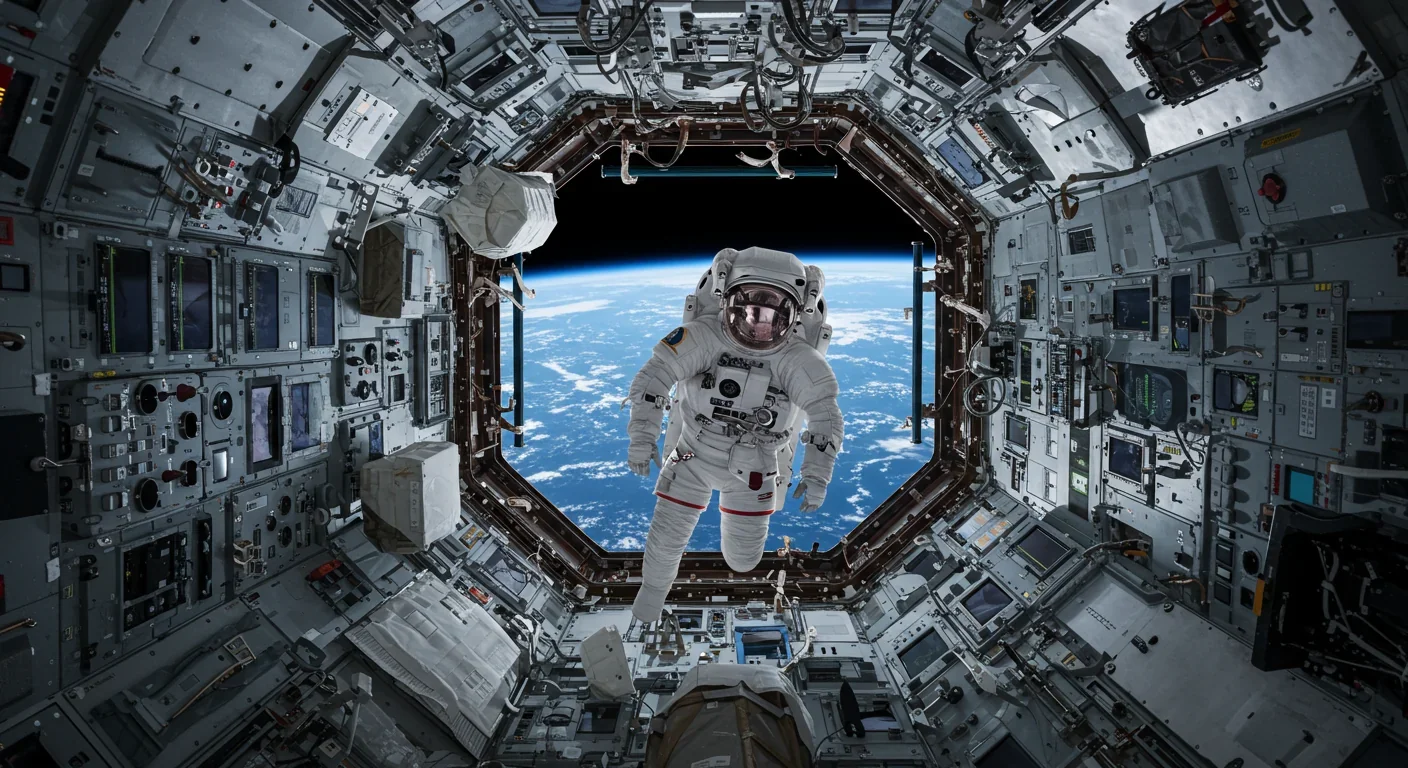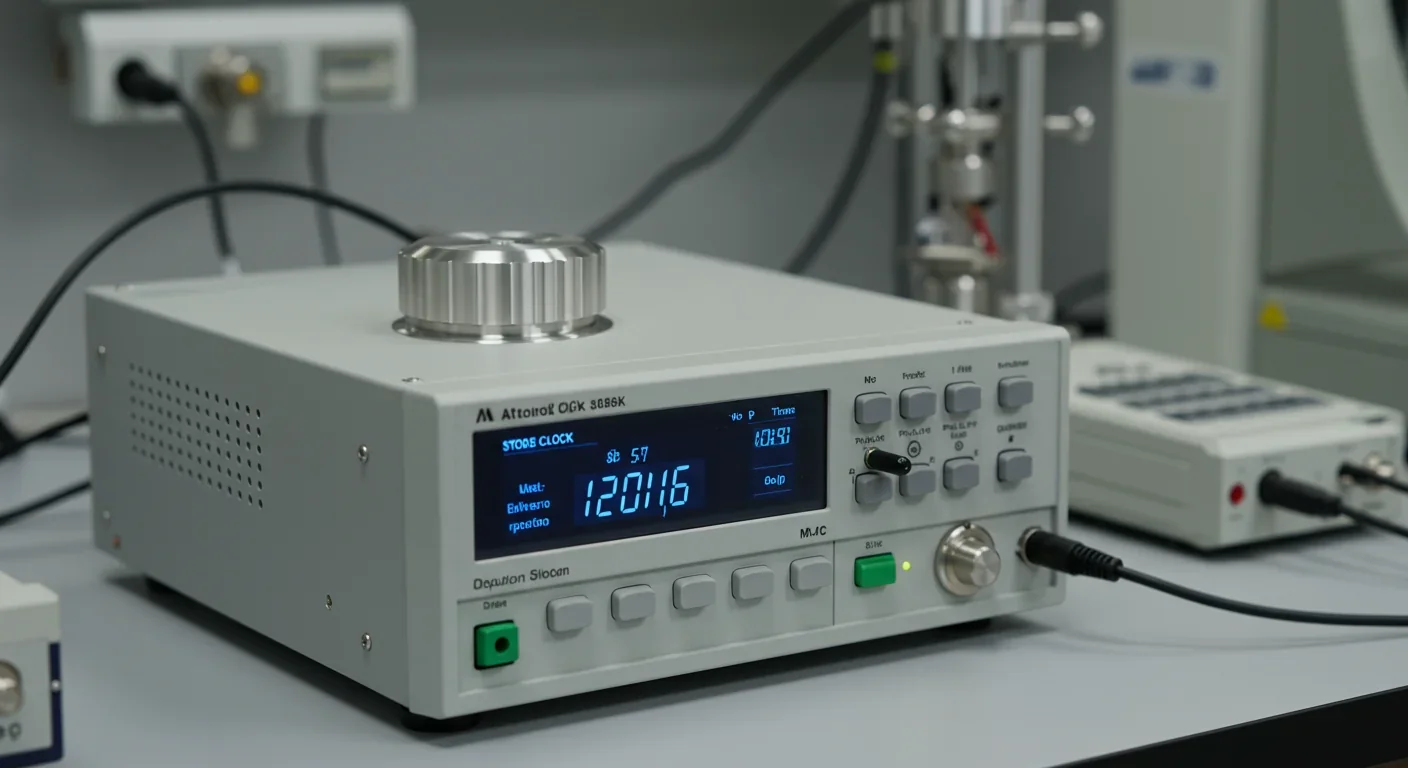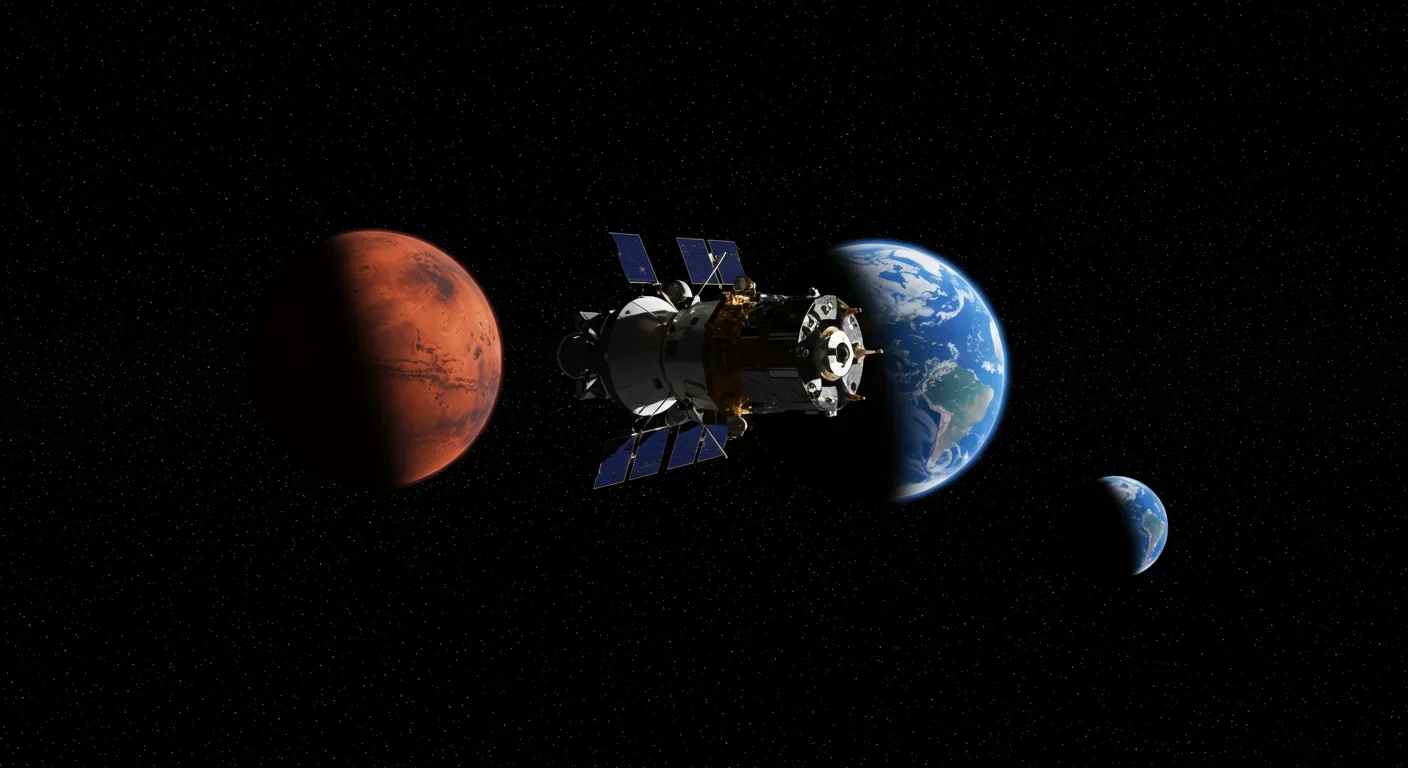Fusion Rockets Could Reach 10% Light Speed: The Breakthrough

TL;DR: Time dilation isn't science fiction—it's a measurable reality for astronauts orbiting Earth. As humanity pushes toward Mars and beyond, understanding how velocity and gravity warp time has evolved from theoretical physics to survival engineering that shapes mission planning, navigation, and the future of space exploration.

Picture this: An astronaut returns from six months aboard the International Space Station. She's 0.005 seconds younger than if she'd stayed on Earth. That fraction seems microscopic, but it represents something profound—time itself bent around her journey. Within the next decade, as we push toward Mars and beyond, understanding time dilation won't be just theoretical physics. It'll be survival engineering.
Einstein showed us that time isn't the universal metronome we thought it was. It stretches, compresses, and shifts depending on how fast you're moving and where you are in a gravitational field. For anyone traveling beyond Earth, these relativistic effects become real constraints that mission planners must navigate with the same care they give to fuel calculations and radiation shielding.
When Einstein published his theory of special relativity in 1905, he revealed something unsettling: time depends on your state of motion. Move faster, and your clock ticks slower relative to someone standing still. This isn't a malfunction or an illusion—it's the fundamental architecture of spacetime.
The math behind it involves what physicists call the Lorentz transformation, which describes how space and time coordinates change between observers moving at different speeds. The key factor is gamma (γ), which grows larger as velocity approaches the speed of light. At everyday speeds, gamma stays close to 1, meaning the effect is negligible. But once you're moving at thousands of kilometers per second—like spacecraft in orbit—the numbers start to matter.
General relativity added another wrinkle: gravity also warps time. A clock on a mountaintop ticks faster than one at sea level because gravity is weaker at higher altitudes. The stronger the gravitational pull, the slower time flows. This means astronauts orbiting Earth experience two opposing relativistic effects simultaneously: their velocity slows their clocks down (special relativity), while their weaker gravitational environment speeds them up (general relativity).
For the ISS, which orbits at roughly 400 kilometers altitude and speeds around Earth at 7.67 kilometers per second, the velocity effect wins out. Astronauts age slightly slower than people on the ground—about a few microseconds per day. Over a six-month mission, that accumulates to milliseconds. Small, but measurable with atomic clocks.
These aren't just theoretical predictions. In 1971, physicists Joseph Hafele and Richard Keating flew atomic clocks around the world on commercial airliners and compared them to ground-based clocks. The airborne clocks showed exactly the time shift Einstein's equations predicted. More dramatic confirmation came from particle accelerators, where muons—subatomic particles—traveling at near-light speeds lived 29 times longer than they do at rest, precisely matching relativistic calculations.

Right now, crew members aboard the ISS are living proof that time dilation isn't science fiction. Every orbit, they're experiencing a slightly different flow of time than the rest of humanity. The ISS completes an orbit every 92.9 minutes, traveling fast enough that special relativistic effects become detectable.
The practical consequence? Their biological clocks, their mission timelines, and the atomic clocks aboard the station all run imperceptibly slower than identical systems on Earth. But here's the catch: astronauts don't feel any different. Time dilation doesn't create a subjective experience of slowness or speed. As physicist Carlo Rovelli noted, our naive perception of time's flow doesn't correspond to physical reality.
From the astronaut's perspective, a second feels like a second. It's only when you compare their clock to one on Earth that the difference emerges. This means the psychological effects of time dilation are essentially zero—astronauts aren't wrestling with existential time confusion. The challenges are purely operational: keeping systems synchronized, coordinating communications, and ensuring that scientific experiments account for the temporal offset.
However, there's an interesting biological wrinkle. While time dilation predicts astronauts should age slightly slower, cellular studies show that space itself is a harsh environment. Microgravity, cosmic radiation, and other stressors accelerate cellular aging in ways that likely dwarf any anti-aging benefit from time dilation. As stem cell biologist Catriona Jamieson observed, "Space is the ultimate stress test for the human body."
If you've ever used GPS to navigate, you've relied on relativistic corrections whether you knew it or not. GPS satellites orbit about 20,000 kilometers above Earth, moving at roughly 14,000 kilometers per hour. At that altitude and velocity, both special and general relativistic effects distort time.
The gravitational time dilation makes satellite clocks run about 45 microseconds per day faster than ground clocks, while velocity-based time dilation makes them run about 7 microseconds per day slower. The net effect: satellite clocks gain roughly 38 microseconds daily compared to Earth. That might sound trivial, but GPS relies on nanosecond-level precision to calculate your position. Without relativistic corrections, your GPS would drift by several miles each day.
Engineers solved this by programming GPS satellites to tick at a slightly different rate—they're deliberately set to run slower so that once relativistic effects kick in, they sync perfectly with ground-based time. It's a brilliant example of turning Einstein's equations into practical engineering. As one explanation put it: "Even a tiny change matters for a high-precision navigation system."
This same principle extends to all space-based timekeeping. International Atomic Time (TAI), the global standard maintained by hundreds of atomic clocks worldwide, requires corrections for altitude. Clocks aboard aircraft and satellites are adjusted for their height above sea level to maintain accuracy. The Pound-Rebka experiment in 1960 confirmed that photons produced near Earth's surface are higher in frequency by 1.09 parts in 10^16 for each meter of elevation, validating the gravitational redshift Einstein predicted.
For spacecraft ephemerides—the tables that tell us where planets and probes are at any given moment—relativistic terms are baked directly into the equations. Barycentric Dynamical Time (TDB), the time scale used for planetary motion, explicitly incorporates relativity. Without these corrections, we couldn't navigate spacecraft accurately or predict celestial events.

When NASA and other space agencies design missions, time dilation is part of the blueprint from day one. It's not an exotic edge case—it's a fundamental parameter alongside propulsion, life support, and communications.
For the ISS, the effect is small enough that it doesn't disrupt daily operations, but it still requires monitoring. Atomic clocks aboard the station need periodic synchronization with ground-based time standards. Scientific experiments that depend on precise timing—particle physics studies, biological rhythms research, fluid dynamics—must account for the temporal offset.
As missions push farther from Earth, the relativistic bookkeeping gets more complex. Consider a Mars mission: spacecraft traveling to the Red Planet won't experience dramatic time dilation because interplanetary velocities are still modest compared to light speed. But once you factor in communications lag (up to 22 minutes each way at Mars's farthest point) and the gravitational differences between Earth, deep space, and Mars surface, mission planners face a three-body time synchronization problem.
Communication protocols have to anticipate this. You can't have a real-time conversation with someone on Mars, so mission control and astronauts rely on asynchronous messaging and autonomous decision-making. Time dilation adds another layer: mission clocks, spacecraft clocks, and Earth clocks all need to be kept in a common reference frame so that scheduled events—engine burns, experiment timings, rendezvous maneuvers—happen when they're supposed to.
Trajectory calculations also hinge on relativistic corrections. When plotting a course to another planet, engineers use equations that incorporate the warping of spacetime by the Sun's gravity. These corrections might shift a trajectory by only a few kilometers, but over interplanetary distances, that's the difference between landing where you intended and missing your target entirely.
One of the most dramatic illustrations of time dilation's practical impact comes from historical measurements. The Hafele-Keating experiment didn't just confirm Einstein's theory—it showed that even at airliner speeds (around 900 kilometers per hour), atomic clocks could detect the difference. Today's instruments are far more sensitive.
Modern atomic clocks can measure time to within a few parts in 10^18, meaning they'd lose or gain less than a second over the age of the universe. This precision reveals relativistic effects at scales that were invisible decades ago. Scientists have measured gravitational time dilation between clocks separated by just one meter of elevation.
For astronauts, this means every mission generates a measurable temporal offset. Scott Kelly, who spent nearly a year aboard the ISS, returned to Earth a fraction of a second younger than if he'd stayed on the ground. His twin brother Mark, also an astronaut but Earthbound during Scott's long mission, served as a unique control in NASA's twin study—though the primary focus was biological changes, not time dilation.
But here's where it gets interesting for future missions: if we ever achieve interstellar travel at a significant fraction of light speed, time dilation stops being a subtle correction and becomes existential. At 90% the speed of light, gamma equals about 2.3, meaning astronauts would age at less than half the rate of people on Earth. A ten-year mission for the crew could mean twenty-three years pass back home. This isn't science fiction speculation—it's just Einstein's equations playing out at higher velocities.
Right now, time dilation is a precision concern. In the coming decades, as humanity establishes bases on the Moon and Mars, it'll become a logistical necessity.
Mars missions will involve round trips of 18 to 30 months, depending on orbital alignments. The velocities won't be much higher than current spacecraft, so time dilation effects will remain small—likely just a few seconds accumulated over the entire journey. But Mars presents a different challenge: its gravitational field is about 38% of Earth's, creating a distinct temporal reference frame. A clock on Mars surface ticks at a different rate than one on Earth, though the difference is tiny.
For a permanent Mars settlement, mission planners will need synchronized time standards that account for these differences. Imagine coordinating supply missions, scientific experiments, and communications between Earth, orbital stations, and Mars bases—all operating in slightly different temporal flows. It's like managing a global logistics network where every location has a slightly different clock speed.
Deep-space missions to the outer planets or beyond will push these challenges further. Spacecraft venturing to Jupiter, Saturn, or the Kuiper Belt will spend years in transit, accumulating relativistic offsets. The gravitational environment changes dramatically as you move through the solar system—Jupiter's immense mass creates a much deeper gravity well than Mars, affecting time dilation in measurable ways.
Future propulsion technologies could make time dilation a dominant factor. If we develop fusion drives or antimatter engines capable of accelerating spacecraft to 10% or 20% of light speed, relativistic effects would become significant. At 20% light speed, gamma is about 1.02, meaning time aboard the spacecraft runs about 2% slower than on Earth. Over a decade-long mission, that's months of temporal difference.
For all the equations and engineering, there's a deeply human dimension to time dilation that we're only beginning to grapple with. Astronauts returning from long missions already experience a form of temporal dislocation—the world has moved on, seasons have changed, children have grown. Time dilation, even at microsecond scales, adds a literal truth to that feeling: they've lived through less time than the people they left behind.
As missions grow longer and faster, this gap could widen. Future astronauts traveling to nearby stars might return to find that generations have passed on Earth. Their families, their culture, even their language could have evolved beyond recognition. This creates not just a technical challenge, but a psychological and social one.
Some physicists and futurists suggest that time dilation could become a tool rather than a problem. If you want to travel to a distant star system but don't want to experience centuries of subjective time, traveling at near-light speeds would compress your personal timeline. The universe outside ages rapidly, but from your perspective, the journey is much shorter. It's a form of one-way time travel into the future.
But that raises profound questions. How do you maintain relationships across relativistic distances? How do societies adapt when some members age at different rates? How do legal systems handle contracts and responsibilities when time itself is relative? These aren't hypothetical—they're the inevitable consequences of taking Einstein's universe seriously.
We've spent a century confirming that Einstein was right: time bends, stretches, and shifts depending on how you move through the universe. For most of human history, this didn't matter. We lived slow, stayed close to Earth's surface, and never noticed that time was anything but uniform.
Now, as we become a spacefaring species, we can't ignore it anymore. Every satellite, every spacecraft, every astronaut in orbit is a reminder that time isn't what our intuition tells us it is. It's a dimension woven into the fabric of spacetime, shaped by mass and velocity, different for every observer.
The good news is that we've learned to work with it. GPS proves we can turn relativity into reliable technology. The ISS shows we can live and work in an environment where time flows differently. The equations are well understood, the engineering solutions are mature, and the operational protocols are tested.
As we look ahead—toward lunar bases, Mars colonies, asteroid mining, and eventually interstellar exploration—time dilation will evolve from a precision correction to a defining constraint. Mission planners will design around it, engineers will build systems that compensate for it, and astronauts will live within its effects daily.
The universe, it turns out, runs on Einstein's clock. The more we explore it, the more we'll learn to sync our watches—not just with each other, but with spacetime itself.

Recent breakthroughs in fusion technology—including 351,000-gauss magnetic fields, AI-driven plasma diagnostics, and net energy gain at the National Ignition Facility—are transforming fusion propulsion from science fiction to engineering frontier. Scientists now have a realistic pathway to accelerate spacecraft to 10% of light speed, enabling a 43-year journey to Alpha Centauri. While challenges remain in miniaturization, neutron management, and sustained operation, the physics barriers have ...

Epigenetic clocks measure DNA methylation patterns to calculate biological age, which predicts disease risk up to 30 years before symptoms appear. Landmark studies show that accelerated epigenetic aging forecasts cardiovascular disease, diabetes, and neurodegeneration with remarkable accuracy. Lifestyle interventions—Mediterranean diet, structured exercise, quality sleep, stress management—can measurably reverse biological aging, reducing epigenetic age by 1-2 years within months. Commercial ...

Data centers consumed 415 terawatt-hours of electricity in 2024 and will nearly double that by 2030, driven by AI's insatiable energy appetite. Despite tech giants' renewable pledges, actual emissions are up to 662% higher than reported due to accounting loopholes. A digital pollution tax—similar to Europe's carbon border tariff—could finally force the industry to invest in efficiency technologies like liquid cooling, waste heat recovery, and time-matched renewable power, transforming volunta...

Humans are hardwired to see invisible agents—gods, ghosts, conspiracies—thanks to the Hyperactive Agency Detection Device (HADD), an evolutionary survival mechanism that favored false alarms over fatal misses. This cognitive bias, rooted in brain regions like the temporoparietal junction and medial prefrontal cortex, generates religious beliefs, animistic worldviews, and conspiracy theories across all cultures. Understanding HADD doesn't eliminate belief, but it helps us recognize when our pa...

The bombardier beetle has perfected a chemical defense system that human engineers are still trying to replicate: a two-chamber micro-combustion engine that mixes hydroquinone and hydrogen peroxide to create explosive 100°C sprays at up to 500 pulses per second, aimed with 270-degree precision. This tiny insect's biochemical marvel is inspiring revolutionary technologies in aerospace propulsion, pharmaceutical delivery, and fire suppression. By 2030, beetle-inspired systems could position sat...

The U.S. faces a catastrophic care worker shortage driven by poverty-level wages, overwhelming burnout, and systemic undervaluation. With 99% of nursing homes hiring and 9.7 million openings projected by 2034, the crisis threatens patient safety, family stability, and economic productivity. Evidence-based solutions—wage reforms, streamlined training, technology integration, and policy enforcement—exist and work, but require sustained political will and cultural recognition that caregiving is ...

Every major AI model was trained on copyrighted text scraped without permission, triggering billion-dollar lawsuits and forcing a reckoning between innovation and creator rights. The future depends on finding balance between transformative AI development and fair compensation for the people whose work fuels it.